Ex Situ Synthesis and Characterizations of MoS2/WO3 Heterostructures for Efficient Photocatalytic Degradation of RhB
Abstract
:1. Introduction
2. Materials and Methods
2.1. Synthesis of MoS2
2.2. Synthesis of WO3
2.3. Synthesis of MoS2/WO3
2.4. Photocatalytic Activity
3. Results and Discussion
3.1. Structural Analysis
3.2. Morphological Analysis
3.3. FTIR Analysis
3.4. UV-Visible Spectroscopy Analysis
3.5. RhB Photodegradation
3.6. Proposed Photocatalytic Mechanism
4. Conclusions
Supplementary Materials
Author Contributions
Funding
Data Availability Statement
Acknowledgments
Conflicts of Interest
References
- Wang, R.; Zhang, W.; Zhu, W.; Yan, L.; Li, S.; Chen, K.; Hu, N.; Suo, Y.; Wang, J. Enhanced visible-light-driven photocatalytic sterilization of tungsten trioxide by surface-engineering oxygen vacancy and carbon matrix. Chem. Eng. J. 2018, 348, 292–300. [Google Scholar] [CrossRef]
- Oller, I.; Malato, S.; Sánchez Pérez, J.A. Combination of Advanced Oxidation Processes and biological treatments for wastewater decontamination—A review. Sci. Total Environ. 2011, 409, 4141–4166. [Google Scholar] [CrossRef] [PubMed]
- Bai, X.; Yang, L.; Hagfeldt, A.; Johansson, E.M.; Jin, P. D35-TiO2 nano-crystalline film as a high performance visible-light photocatalyst towards the degradation of bis-phenol A. Chem. Eng. J. 2018, 355, 999–1010. [Google Scholar] [CrossRef]
- Ullattil, S.G.; Narendranath, S.B.; Pillai, S.C.; Periyat, P. Black TiO2 Nanomaterials: A Review of Recent Advances. Chem. Eng. J. 2018, 343, 708–736. [Google Scholar] [CrossRef]
- Mohite, S.; Ganbavle, V.; Rajpure, K. Solar photoelectrocatalytic activities of rhodamine-B using sprayed WO3 photoelectrode. J. Alloys Compd. 2015, 655, 106–113. [Google Scholar] [CrossRef]
- Fu, Y.-D.; Feng, X.-X.; Yan, M.-F.; Wang, K.; Wang, S.-Y. First principle study on electronic structure and optical phonon properties of 2H-MoS2. Phys. B Condens. Matter 2013, 426, 103–107. [Google Scholar] [CrossRef]
- Lee, C.; Yan, H.; Brus, L.E.; Heinz, T.F.; Hone, J.; Ryu, S. Anomalous Lattice Vibrations of Single- and Few-Layer MoS2. ACS Nano 2010, 4, 2695–2700. [Google Scholar] [CrossRef] [PubMed]
- Rakibuddin, M.; Kim, H. Fabrication of MoS2/WO3 nanocomposite films for enhanced electrochromic performance. New J. Chem. 2017, 41, 15327–15333. [Google Scholar] [CrossRef]
- Singla, S.; Sharma, S.; Basu, S. MoS2/WO3 heterojunction with the intensified photocatalytic performance for decomposition of organic pollutants under the broad array of solar light. J. Clean. Prod. 2021, 324, 129290. [Google Scholar] [CrossRef]
- Guo, M.; Xing, Z.; Zhao, T.; Li, Z.; Yang, S.; Zhou, W. WS2 quantum dots/MoS2@WO3-x core-shell hierarchical dual Z-scheme tandem heterojunctions with wide-spectrum response and enhanced photocatalytic performance. Appl. Catal. B Environ. 2019, 257, 117913. [Google Scholar] [CrossRef]
- Tanveer, M.; Cao, C.; Aslam, I.; Ali, Z.; Idrees, F.; Tahir, M.; Khan, W.S.; Butt, F.K.; Mahmood, A. Effect of the morphology of CuS upon the photocatalytic degradation of organic dyes. RSC Adv. 2014, 4, 63447–63456. [Google Scholar] [CrossRef]
- Simelane, S.; Ngila, J.C.; Dlamini, L.N. The effect of humic acid on the stability and aggregation kinetics of WO3 nanoparticles. Part. Sci. Technol. 2017, 35, 632–642. [Google Scholar] [CrossRef]
- Zheng, Y.; Wang, J.; Wang, Y.; Zhou, H.; Pu, Z.; Yang, Q.; Huang, W. The combination of MoS2/WO3 and its adsorption properties of methylene blue at low temperatures. Molecules 2019, 25, 2. [Google Scholar] [CrossRef] [PubMed]
- Idrees, F.; Cao, C.; Butt, F.K.; Tahir, M.; Tanveer, M.; Aslam, I.; Ali, Z.; Mahmood, T.; Hou, J. Facile synthesis of novel Nb3O7 F nanoflowers, their optical and photocatalytic properties. CrystEngComm 2013, 15, 8146–8152. [Google Scholar] [CrossRef]
- Idrees, F.; Cao, C.; Ahmed, R.; Butt, F.; Butt, S.; Tahir, M.; Tanveer, M.; Aslam, I.; Ali, Z. Novel Nano-Flowers of Nb2O5 by Template Free Synthesis and Enhanced Photocatalytic Response Under Visible Light. Sci. Adv. Mater. 2015, 7, 1298–1303. [Google Scholar] [CrossRef]
- Ganesh, I.; Kumar, P.P.; Annapoorna, I.; Sumliner, J.M.; Ramakrishna, M.; Hebalkar, N.Y.; Padmanabham, G.; Sundararajan, G. Preparation and characterization of Cu-doped TiO2 materials for electrochemical, photoelectrochemical, and photocatalytic applications. Appl. Surf. Sci. 2014, 293, 229–247. [Google Scholar] [CrossRef]
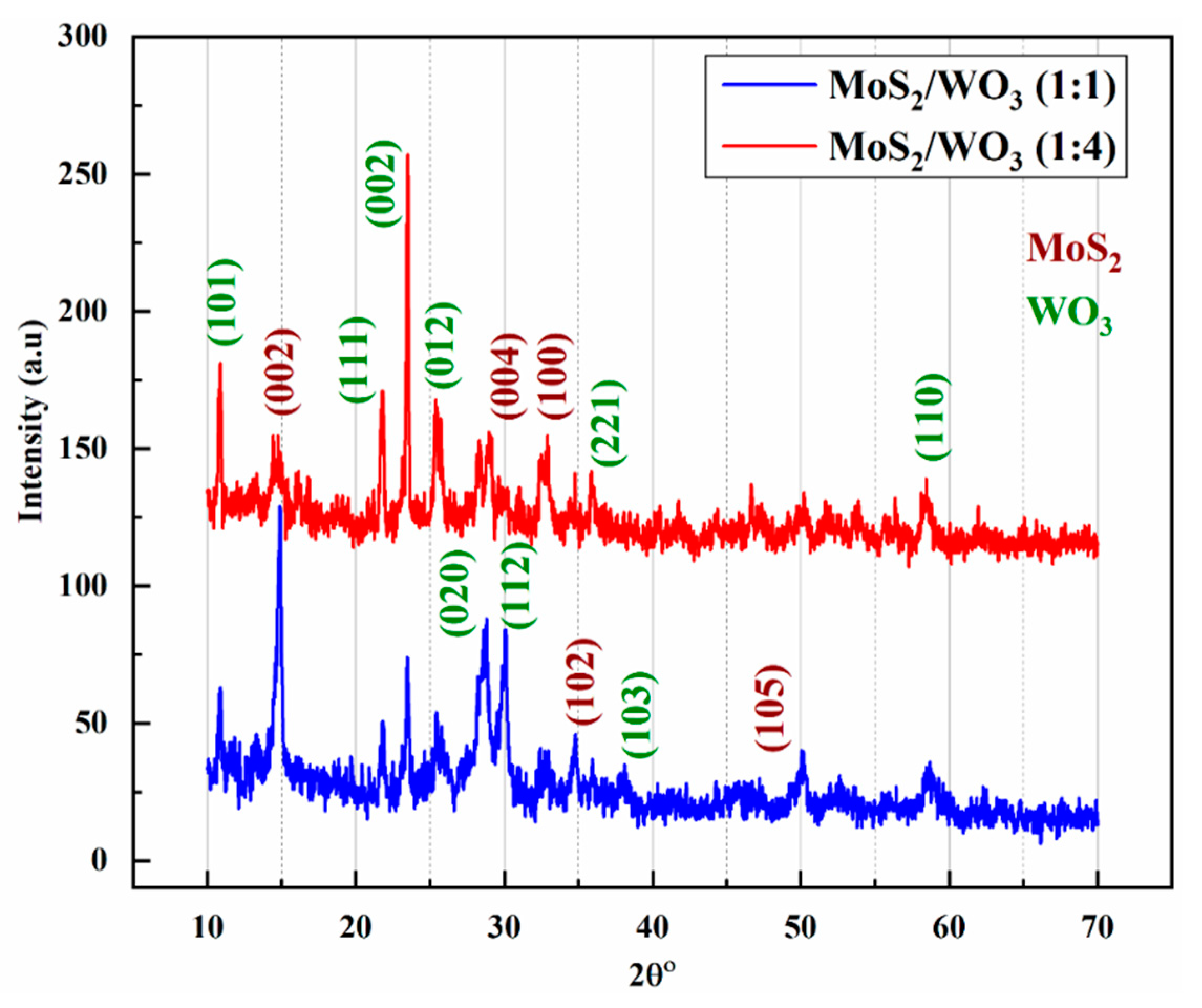
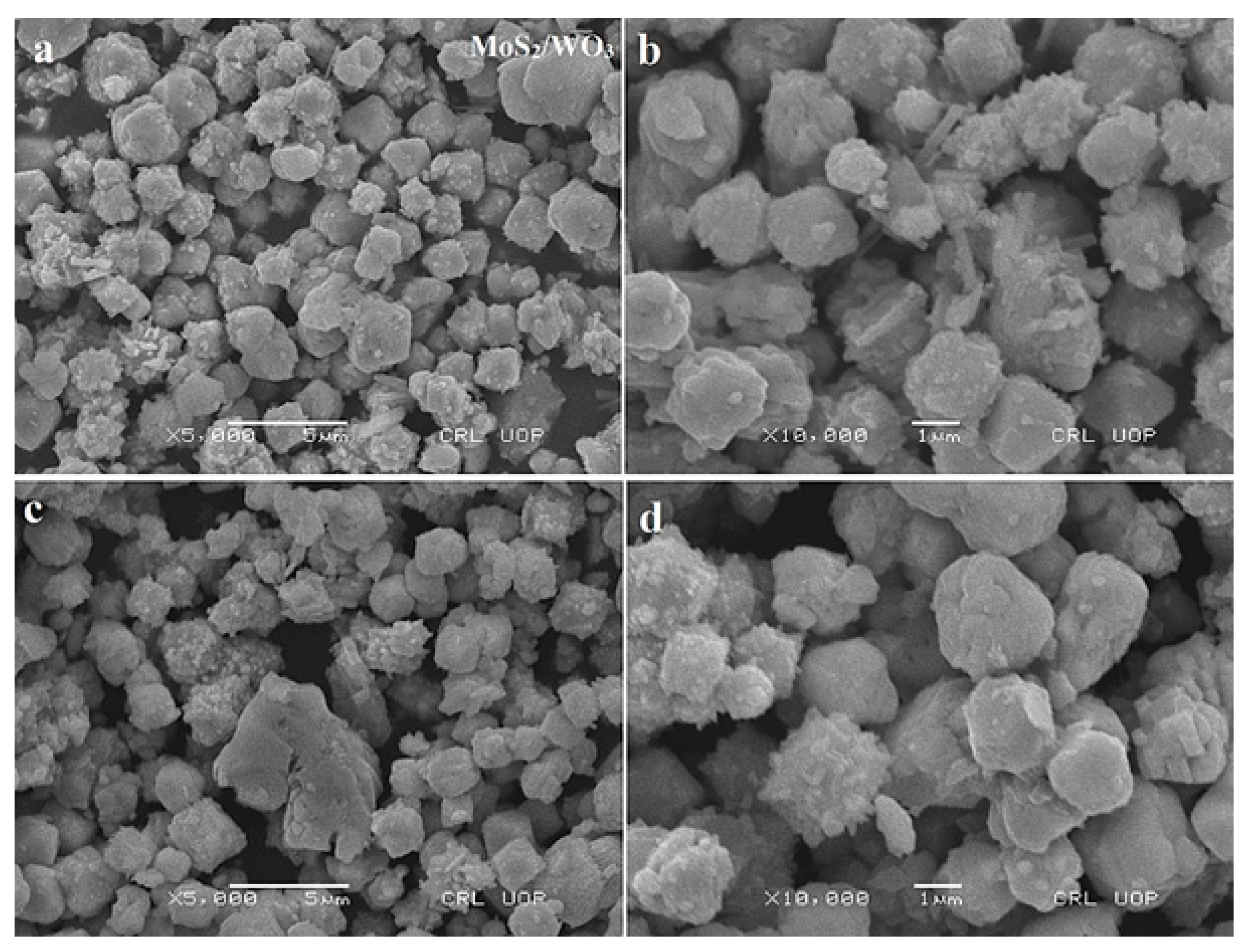
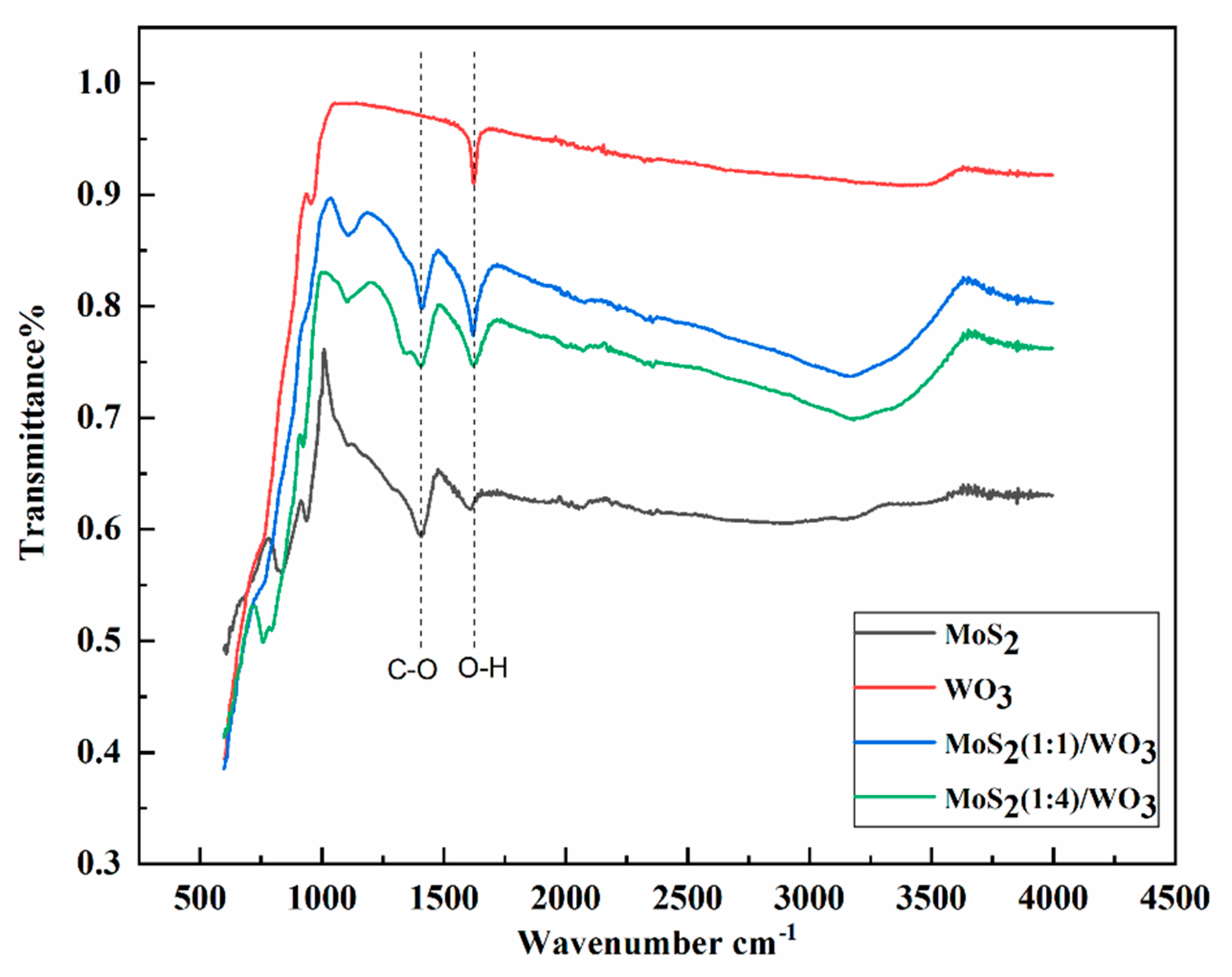
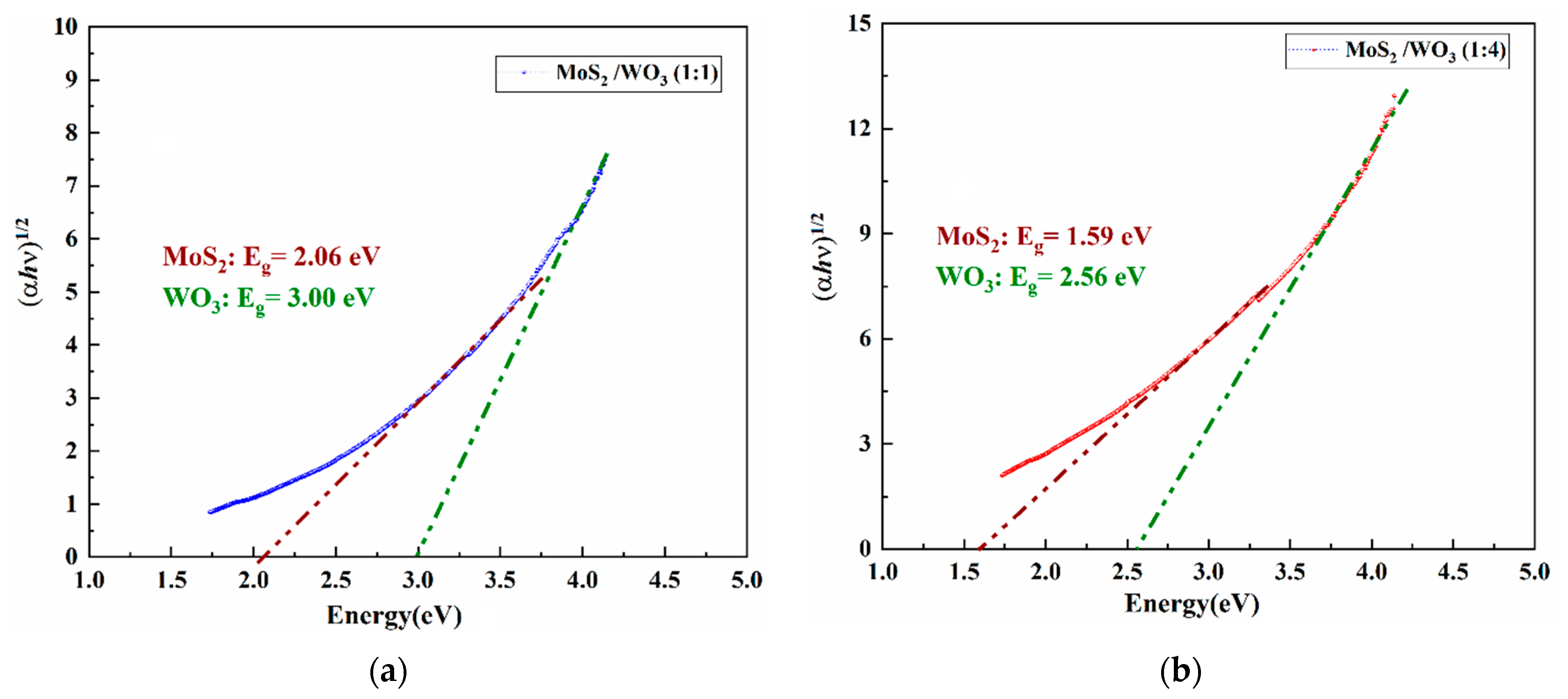
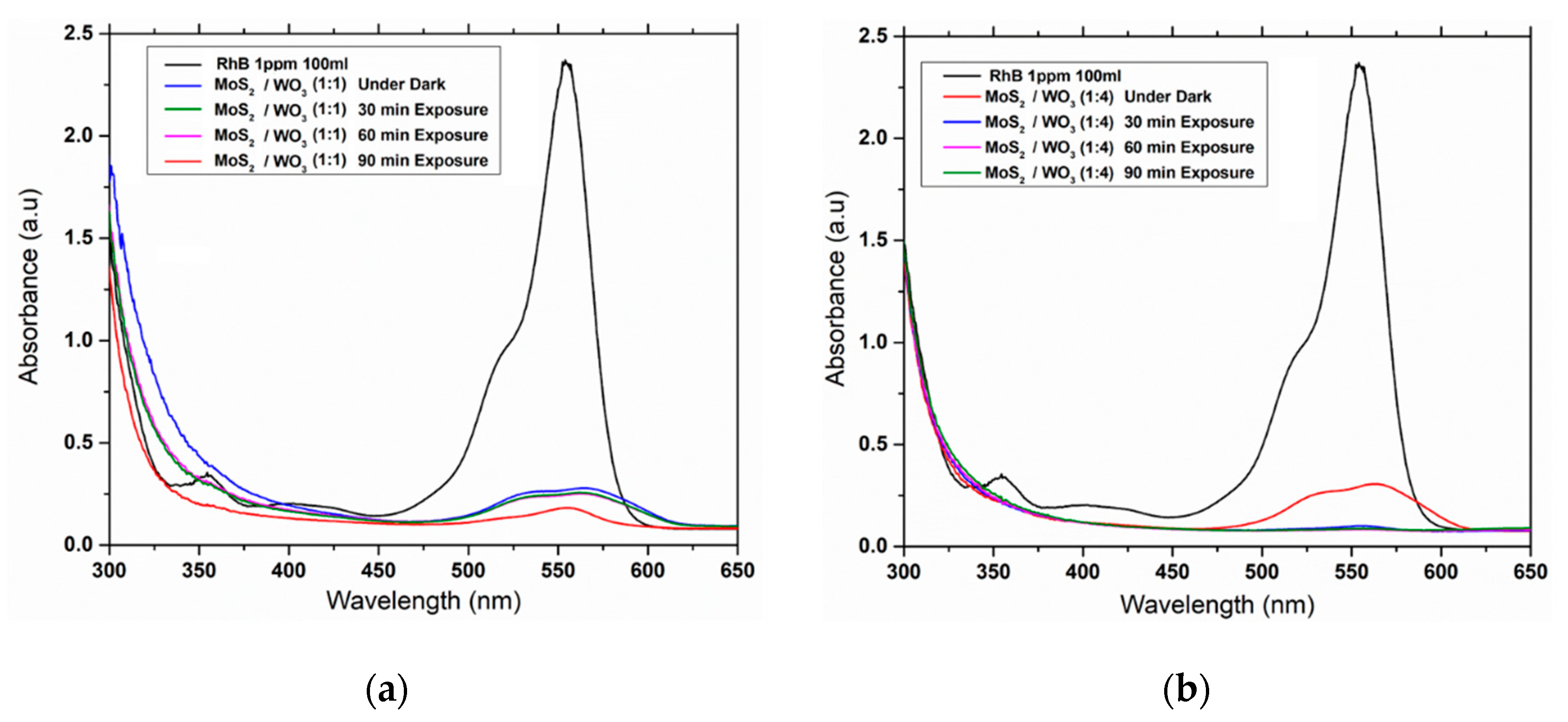
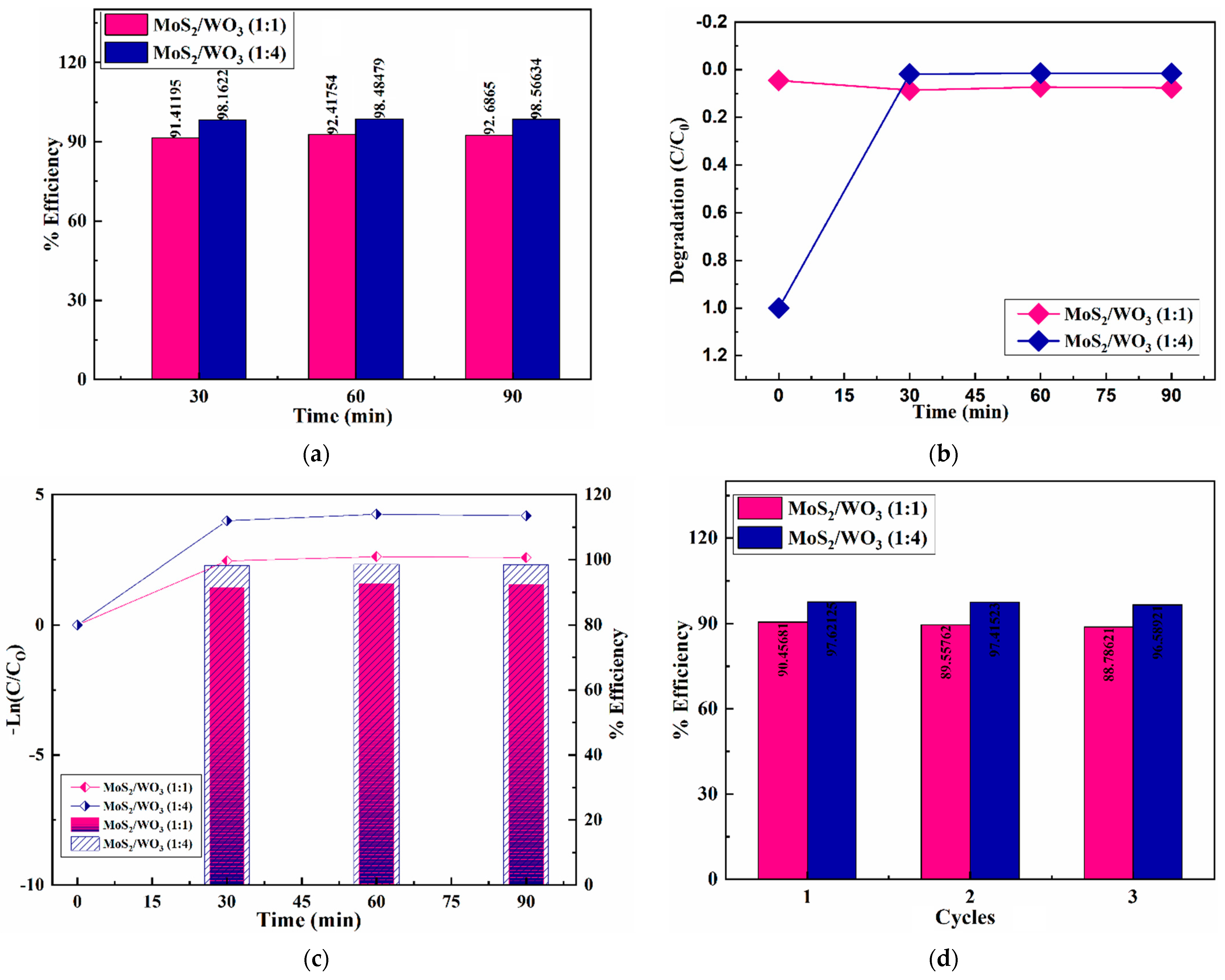
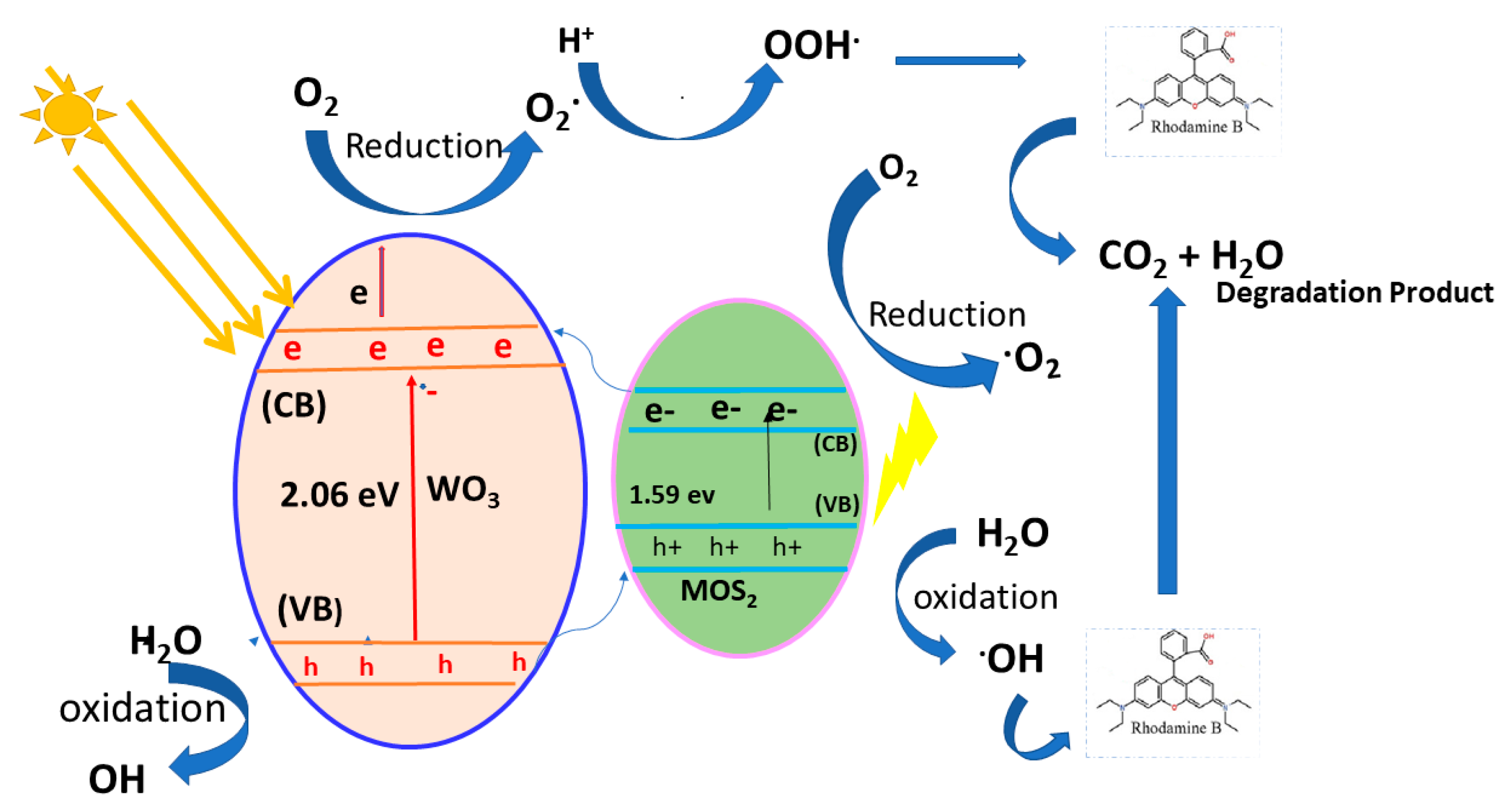
Publisher’s Note: MDPI stays neutral with regard to jurisdictional claims in published maps and institutional affiliations. |
© 2022 by the authors. Licensee MDPI, Basel, Switzerland. This article is an open access article distributed under the terms and conditions of the Creative Commons Attribution (CC BY) license (https://creativecommons.org/licenses/by/4.0/).
Share and Cite
Shahid, W.; Idrees, F.; Iqbal, M.A.; Tariq, M.U.; Shahid, S.; Choi, J.R. Ex Situ Synthesis and Characterizations of MoS2/WO3 Heterostructures for Efficient Photocatalytic Degradation of RhB. Nanomaterials 2022, 12, 2974. https://doi.org/10.3390/nano12172974
Shahid W, Idrees F, Iqbal MA, Tariq MU, Shahid S, Choi JR. Ex Situ Synthesis and Characterizations of MoS2/WO3 Heterostructures for Efficient Photocatalytic Degradation of RhB. Nanomaterials. 2022; 12(17):2974. https://doi.org/10.3390/nano12172974
Chicago/Turabian StyleShahid, Wajeehah, Faryal Idrees, Muhammad Aamir Iqbal, Muhammad Umair Tariq, Samiah Shahid, and Jeong Ryeol Choi. 2022. "Ex Situ Synthesis and Characterizations of MoS2/WO3 Heterostructures for Efficient Photocatalytic Degradation of RhB" Nanomaterials 12, no. 17: 2974. https://doi.org/10.3390/nano12172974
APA StyleShahid, W., Idrees, F., Iqbal, M. A., Tariq, M. U., Shahid, S., & Choi, J. R. (2022). Ex Situ Synthesis and Characterizations of MoS2/WO3 Heterostructures for Efficient Photocatalytic Degradation of RhB. Nanomaterials, 12(17), 2974. https://doi.org/10.3390/nano12172974






